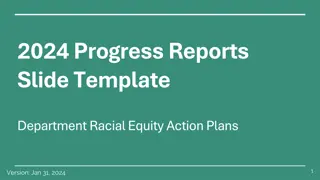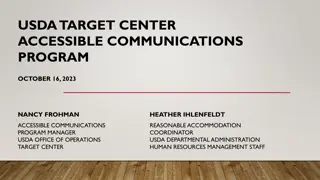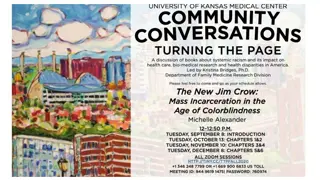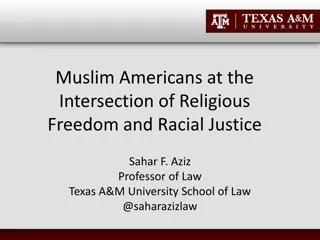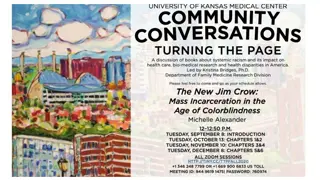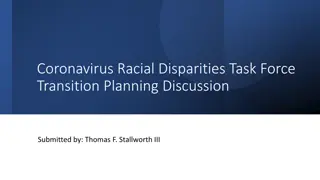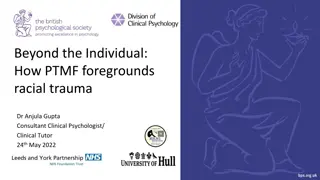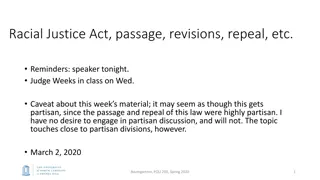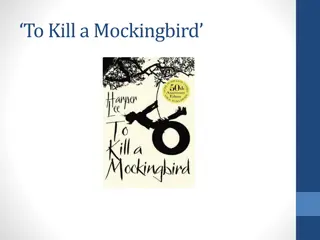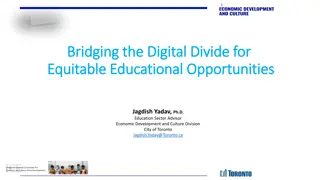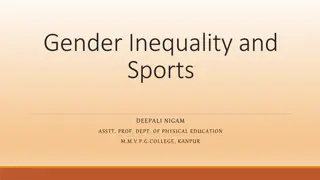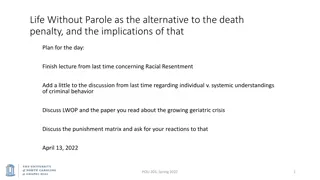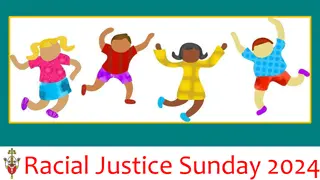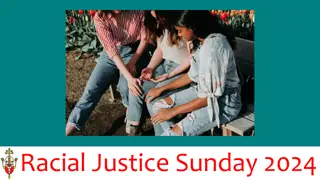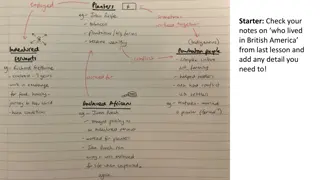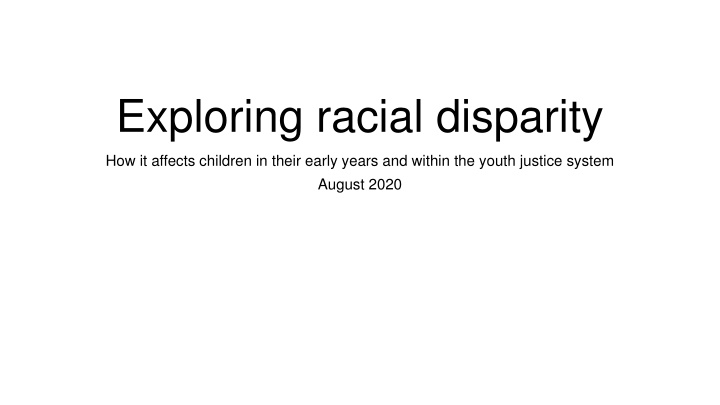
Exploring Racial Disparity in Early Years & Youth Justice System - August 2020
"Delve into racial disparities affecting children in early years and the youth justice system in England and Wales. Explore systemic biases, workforce diversity, and plans for ethnic disproportionality."
Download Presentation

Please find below an Image/Link to download the presentation.
The content on the website is provided AS IS for your information and personal use only. It may not be sold, licensed, or shared on other websites without obtaining consent from the author. If you encounter any issues during the download, it is possible that the publisher has removed the file from their server.
You are allowed to download the files provided on this website for personal or commercial use, subject to the condition that they are used lawfully. All files are the property of their respective owners.
The content on the website is provided AS IS for your information and personal use only. It may not be sold, licensed, or shared on other websites without obtaining consent from the author.
E N D
Presentation Transcript
Exploring racial disparity How it affects children in their early years and within the youth justice system August 2020
Message from Keith Fraser, YJB Chairman: If we truly want to bring about change and live in a fair society with equal access to opportunities we must ensure that over-representation remains at the forefront of our thinking. If you work in the youth justice system, please ask yourself, are children from black, Asian and minority ethnic backgrounds over-represented in your area? If so, can you explain why that is, and if you can t what are you going to do about it?
Introduction We have produced this presentation to highlight the areas where over- representation occurs, and show how, from a very early age and within the youth justice system, there are systemic and institutional prejudices that result in some children not receiving equal treatment. It s unacceptable that a child is more likely to be criminalised because of their background. That is why, in our business plan, we have outlined the work we intend to deliver to tackle ethnic disproportionality within the youth justice system. We have also included a summary of current plans for the YJB and Youth Custody Service that will make a difference.
Children in England and Wales Data from the 2011 Census provides a breakdown of the number of children in England and Wales by ethnicity. White, 81% Asian, 9% Black, 4% Mixed, 4% Other, 1% Source: https://www.ons.gov.uk/census/2011census/howourcensusworks/howdidwedoin2011/2011 censusgeneralreport
The youth justice workforce As part of the YJB s Workforce Development Strategy we monitor the ethnic diversity of the youth offending team (YOT) workforce. This is because we think it is important that the workforce reflects the community that it represents. The YJB has set up an apprenticeship programme (due to start in 2021) to recruit black, Asian and minority ethnic (BAME), ex-service users and other under-represented groups. In 2018-2019, there were 1,023 people from a BAME background working in YOTs (excluding volunteers), compared to 5,551 overall where ethnicity was known (overall there were 6,153 staff). This amounts to 18% of the total YOT workforce where ethnicity is known.
The youth justice workforce Composition of the youth offending team (YOT) workforce in 2018-19 Role Number of black, Asian and minority ethnic role holders 23 (out of 190) 94 (out of 602) 786 (out of 4,104) 120 (out of 745) 561 (out of 3,220) The YOT workforce (%) Strategic leader Operational manager Practitioner Administrative Volunteer 12% 16% 20% 16% 17% Source: https://assets.publishing.service.gov.uk/government/uploads/system/uploads/attachment_data/file/861776/youth-justice-statistics-additional-annexes-march-2019.zip
Looked-after children In England, the majority of looked-after children are white (74%). 10% were mixed and 8% were black or black British. Since 2015, the proportion of white looked-after children has decreased steadily from 77% to 74%. It is likely this slight change is due to the broadly non-white make up of unaccompanied asylum-seeking children, a group which has recently grown in number. In Wales, 91% of looked-after children were white, 3% were mixed, 2% were Asian or Asian British, 2% were black, African, Caribbean or black British and 2% were other ethnic groups. The proportion of looked-after children who were non-white increased from 6% in 2014-15 to 9% in 2018-19. Sources: https://www.gov.uk/government/statistics/children-looked-after-in-england-including-adoption -2018-to-2019 https://gov.wales/children-looked-after-local-authorities-april-2018-march-2019
Children in need In England, over the last five years there has been a gradual decline in the proportion of children in need that were white, from 75% in 2015 to 72% in 2020. In contrast, there have been slight increases in the percentage whose ethnicity was mixed (from 8% to 9%) or black (8% to 9%) and no change in the percentage of those whose ethnicity was Asian (7%). In Wales, of children for whom ethnicity was known, 93% of children receiving care and support were white, 3% were mixed, 2% were Asian and 1% were black. Sources: https://www.gov.uk/government/statistics/characteristics-of-children-in-need-2018-to-2019 https://gov.wales/wales-children-receiving-care-and-support-census-31-march-2019
Mental health The nature of mental health inequality is complex, and affected by factors such as social and economic inequalities, racism and discrimination, stigma and the cultural appropriateness of treatments. Data on children s contact with mental health services in the UK is limited. We cover this subject further in our notes at the end of this presentation.
Mental health: prevalence A 2017 survey of the mental health of children and young people (5 to 19 year olds) in England found Asian/Asian British (5.2%) and black/black British children (5.6%) were roughly three times less likely than white children (14.9%) to have a diagnosable mental disorder. Children from black, Asian and minority ethnic communities are also less likely to engage with services which could intervene early to prevent any mental health issues worsening. Sources: https://digital.nhs.uk/data-and-information/publications/statistical/mental-health-of-children-and-young- people-in-england/2017/2017 http://www.better-health.org.uk/sites/default/files/briefings/downloads/Health%20Briefing%2033(2).pdf
Mental health: rate of detentions In the two years to March 2019, the rate of detentions of black children under the Mental Health Act was 1.7 times more than for white children. In the year to March 2019, black people (not just children) were more than 4 times as likely as white people to be detained under the Mental Health Act. Source: https://digital.nhs.uk/data-and-information/data-collections-and-data-sets/data-sets/mental- health-services-data-set
Socio economic status Compared to the general population, people from Asian and black groups in England were twice as likely to have never worked or be long term unemployed (at 17.5% and 6.2% respectively). This is higher than their share of the general population (7.5% and 3.3% respectively). White 71.1% Black 6.2% Asian 17.5% Mixed 2.5% Other 2.7% Never worked / long term unemployed The general population (2011 Census) 86% 3.3% 7.5% 2.2% 1% Source: https://www.ons.gov.uk/census/2011census
Socio economic status In 2016 to 2018, 17% of households (3.9 million) in England rented their home from a local authority or housing association. Out of the main ethnic groups, the highest proportion of those renting were black. White 16% Black 42% Asian 14% Mixed 29% Other 25% Source: https://www.gov.uk/government/collections/english-housing-survey#2017-to-2018
Socio economic status Households with persistent low income (less than 60% of the average UK income for 3 out of 4 years). The highest proportion of children living in households with persistent low income were from Asian backgrounds. White 10% Black 16% Asian 27% Mixed 9% Source: https://www.gov.uk/government/collections/english-housing-survey#2017-to-2018
Special educational needs The number of pupils with special educational needs (SEN) was 1,318,300 in January 2019, representing 14.9% of the total pupil population. Of the main ethnic groups, black children had the highest percentage of SEN at 16%. Out of the white pupils with SEN, it was most prevalent in travellers of Irish heritage and Gypsy/Roma pupils at 30% and 26% respectively. Source: https://www.gov.uk/government/statistics/special-educational-needs-in-england-january-2019
Key stages 2 and 4 The number of pupils with special educational needs (SEN) was 1,318,300 in January 2019, representing 14.9% of the total pupil population. Key stage 2 attainment in England, percentage of children reaching the expected standard White Black Asian Mixed Chinese Other 64% 64% 69% 66% 80% 61% Key stage 4 attainment in England, percentage of children reaching the expected standard White Black Asian Mixed Chinese Other 46% 45% 50% 47% 64% 47% Sources: https://www.gov.uk/government/statistics/key-stage-2-and-multi-academy-trust-performance-2018-revised https://www.gov.uk/government/statistics/key-stage-4-and-multi-academy-trust-performance-2018-revised
Exclusions In England, GRT pupils had the highest school exclusion rates (both permanent and temporary) in the 2017 and 2018 school year. Traveller of Irish Heritage pupils made up 17.42% of temporary exclusions (or 1,742 exclusions per 10,000 pupils) and Gypsy and Roma pupils made up 16.52% (or 1,652 per 10,000 pupils). Mixed white and black Caribbean pupils were nearly 3 times as likely to be permanently excluded as white British pupils in the 2017/18 (school year). Source: https://www.gov.uk/government/statistics/permanent-and-fixed-period-exclusions-in -england-2017-to-2018
Education, apprenticeships, employment In England, GRT pupils had the highest school exclusion rates (both permanent and temporary) in the 2017 and 2018 school year. Traveller of Irish Heritage pupils made up 17.42% of temporary exclusions (or 1,742 exclusions per 10,000 pupils) and Gypsy and Roma pupils made up 16.52% (or 1,652 per 10,000 pupils). Mixed white and black Caribbean pupils were nearly 3 times as likely to be permanently excluded as white British pupils in the 2017/18 (school year). Gypsy/Roma 67% Irish/Traveller 72% Source: https://www.gov.uk/government/collections/statistics-destinations
Education: what we are doing We worked with the Alliance of Sport to secure a record-breaking 1,000,000 grant from the London Marathon Charitable Trust for Levelling the Playing Field , a sports and physical activity project to benefit children from black, Asian and minority ethnic (BAME) backgrounds at risk of and within the youth justice system. We are working with the Department for Work and Pensions to pilot a mentoring support programme for BAME young people in two London boroughs.
Education: what we are doing We are organising an employability event involving government departments, businesses, the voluntary sector and children to consider how we work together to improve options for employment and training for over-represented children in the youth justice system. We are also developing a Positive Action Apprenticeship Programme for BAME children to widen employment opportunities.
Confidence in the police In the year ending March 2019, 75% of people aged 16 and over in England and Wales said they had confidence in their local police. Among 16-17 year olds, a lower percentage of children with black (61%) and mixed backgrounds (68%) had confidence in their local police than white children (77%).
Victims of crime 16 to 24 year olds from mixed (27%), black (23%) and white (22%) ethnic groups were more likely to be a victim of crime than people in the same age group from Asian (15%) and other (12%) ethnic groups.
Arrests Black children are over four times more likely to be arrested than white children. RRI of arrests per 10,000 children in local 10-17 population, year ending March 2019 Relative rate index (RRI) 4.5 4.0 3.5 3.0 2.5 2.0 1.5 1.0 0.5 - Asian Black Other Mixed White BAME Source: https://www.gov.uk/government/statistics/criminal-justice-system-statistics-quarterly-september-2019
Cautions Of all children arrested, white children are most likely to get a caution and avoid going to court. RRI of children receiving cautions per 100 arrests, year ending March 2018 Relative rate index (RRI) 2.50 2.00 1.50 1.00 0.50 - Asian Black Other White BAME Source: https://www.gov.uk/government/statistics/criminal-justice-system-statistics-quarterly-september-2019
First time entrants to the youth justice system From the year 2014 to 2019, the fall in first time entrants has been larger for white children (57% decrease) than for black, Asian and minority ethnic children. Source: https://www.gov.uk/government/statistics/criminal-justice-system-statistics-quarterly-september-2019
Pre court: what we are doing We have raised issues relating to disproportionality with the National Police Chiefs Council (NPCC). We assisted in identifying options to review force procedures, monitoring and scrutiny. We influenced the guidance issued to stop and search scrutiny panels and visited them to identify good practice in addressing disproportionality. We have influenced the Association of Police and Crime Commissioners guidance on Police and Crime Plans to ensure that disproportionality is considered within these plans.
Pre court: what we are doing We have engaged with the NPCC to assist with out-of-court disposals and disproportionality. We have influenced the guidance on out-of-court disposal scrutiny panels and the requirement to thematically analyse these on the basis of ethnicity.
Pre court: data sharing We have agreed to provide the Association of Police and Crime Commissioners with annual summary data to share with Police and Crime Commissioners (PCCs) nationally. This will enable PCCs to understand ethnic disproportionality data within their remit and consider this information when developing their Police and Crime Plans. We assisted in the development of the Chance to Change deferred prosecution pilot, based on the Lammy review recommendation. This aims to divert children from the youth justice system without the requirement to admit responsibility. This was identified as a significant factor in preventing BAME children from receiving out-of-court disposal options.
Knife possession In 2019 just less than 4,200 knife and offensive weapon offences resulting in a caution or sentence were committed by children. Black children committed over a quarter (27%) of these offences. However there has been a decline in the number of knife offences committed by black children from 1,183 in 2018 to 1,018 in 2019, this is against a rise in the total number of knife offences committed by children, from 4,150 in 2018 to 4,191 in 2019. Source: https://www.gov.uk/government/statistics/knife-and-offensive-weapon-sentencing-statistics -october-to-december-2019
Offences In the year ending March 2019, white children committed 61% of all serious offences (offences with a gravity score of 5 to 8) but only accounted for 51% of children in custody. The most common proven offence across all ethnicities was violence against the person. White children committed 72% of these offences and black, Asian and minority ethnic children committed 28%. Source: https://www.gov.uk/government/statistics/youth-justice-statistics-2018-to-2019
Sentenced to custody Of all children, black, Asian and minority ethnic children were nearly two times as likely to received custodial outcomes than white children. RRI of children sentenced to immediate custody per 1,000 cautioned or convicted, year ending September 2019 Relative rate index (RRI) 2.50 2.00 1.50 1.00 0.50 - Asian Black Other White BAME Source: https://www.gov.uk/government/statistics/criminal-justice-system-statistics-quarterly-september-2019
Assessing the needs of sentenced children The YJB has produced experimental statistics on assessing the needs of sentenced children in the youth justice system. The data, taken from the assessment tool AssetPlus, evidences the experiences and circumstances extent of those children in contact with the youth justice system. Analysis was carried out on assessments of children who received a Referral Order, Reparation Order, Youth Rehabilitation Order or Custodial Sentence between 2018 to 2019. Source: https://www.gov.uk/government/statistics/assessing-the-needs-of-sentenced-children-in- the-youth-justice-system
Assessing the needs of sentenced children Practitioner assessed concerns of sentenced children Overall, a great proportion of black, Asian and minority ethnic (BAME) children were assessed to have concerns (Asian 42%, black 54%, mixed 46%, other 49% and white 37%). Mental health concerns were assessed more for children from a white (75%) ethnic background (Asian 50%, black 57%, mixed 70% and other 65%). Risk of serious harm BAME children were assessed to have a larger proportion of the high or very high ratings for risk of serious harm (Asian 28%, black 44%, mixed 35%, other 35% and white 24%). Safety and Wellbeing ratings Children from a black (55%) ethnic background were assessed to have a larger proportion of a high and very high rating for safety and wellbeing (Asian 32%, mixed 45%, other 48% and white 40%). Source: https://www.gov.uk/government/statistics/assessing-the-needs-of-sentenced-children-in-the- youth-justice-system
Court: what we are doing We are undertaking a statistical analysis of data to help explain the drivers of ethnic disproportionality in remand and sentencing outcomes in the youth justice system. This will be completed in autumn 2020. We are exploring work relating to COVID-19 and the implications for BAME children. We have also explored options for targeted funding in relation to BAME and the COVID-19 response. We have extended the ethnic categorisation within the YOT Case Management Systems to 18+1 which will incorporate Gypsy, Roma and Traveller children. This will enable the YJB to explore and better understand their experience throughout the youth justice system and identify areas for potential work.
Custodial population In the year ending March 2020, black children made up 28% of the population of children in custody. This is 7 times higher than their share in the general population of 10 to 17-year-olds in England and Wales (4%). Sources: https://www.ons.gov.uk/census/2011census/howourcensusworks/howdidwedoin2011/2011censusgeneralreport https://www.gov.uk/government/statistics/youth-custody-data https://www.gov.uk/government/statistics/youth-justice-statistics-2018-to-2019
Custodial population In the year ending March 2020, the number of children in custody from a black background decreased by 10% to account for 28% of the youth custody population. This compares to 15% ten years ago. White Black Asian and other Mixed 48% 28% 10% 12% As of May 2020, provisional data shows that despite a decrease of 24 compared to the previous month (the total is now 319), BAME children made up the majority (53%) of the youth custody population. Sources: https://www.gov.uk/government/statistics/youth-custody-data https://www.gov.uk/government/statistics/youth-justice-statistics-2018-to-2019
Use of remand In the year ending March 2019, black, Asian and minority ethnic (BAME) children were even more over-represented amongst those in custody while on remand. White Black BAME 43% 33% 57% As of May 2020, provisional data shows that despite a decrease of 24 compared to the previous month (the total is now 319), BAME children made up the majority (53%) of the youth custody population. Sources: https://www.gov.uk/government/statistics/youth-custody-data https://www.gov.uk/government/statistics/youth-justice-statistics-2018-to-2019
Behaviour management In the year ending March 2019, the rate of restrictive physical interventions for both white and black, Asian and minority ethnic (BAME) children reached its highest point in the 8 years covered by this data. This was the first year since 2014 that the rate of incidents was higher for white children (47.2) than those from a BAME background (46.3). In the year ending March 2019, the average monthly rate for use of force per 100 children in secure training centres and young offender institutions was highest for white children (60.2 compared to 59.3 for BAME children).
Behaviour management In the year ending March 2019, the rates of assault committed by black, Asian and minority ethnic (BAME) children were higher for children in secure children s homes and secure training centres than for white children. The average monthly rate for assault for BAME children in young offender institutions was higher than for white children. In the year ending March 2019, the rate of self-harm by white children in custody was 2.75 times the rate of BAME children. In the year ending March 2019, the average monthly rates for the use of single separation in secure children s homes and secure training centres were higher for white children (95.9 compared to 78.1 for those from a BAME background).
What the Youth Custody Service is doing The Youth Custody Service (YCS) is identifying and investigating disproportionality in youth custody. Where disparities cannot be explained it is putting in place reforms. This includes improving data accessibility and analysis and driving improvements in service delivery though establishment level plans. The YCS is undertaking a specific programme of work to improve services for girls in custody.
What the Youth Custody Service is doing Staff are being supported through the identification and production of effective practice products and policies that address priority areas relating to diversity and inclusion. The Youth Custody Service will increase the internal supply of black, Asian and minority ethnic employees at all levels who have the skill-set and desire to be senior leaders.
Number of offences Of those children who reoffend, white children offend more often. White children had a rate of 4.22 reoffences per reoffender, Asian children had a rate of 3.46, black children had a rate of 3.62 and children from other backgrounds had a rate of 3.04. Source: https://www.gov.uk/government/collections/proven-reoffending-statistics
Likelihood of reoffending The reoffending rate has consistently been highest for black children over the last ten years. In the latest year, 47% of black children reoffended within 12 months, compared with 39% of white children. Source: https://www.gov.uk/government/collections/proven-reoffending-statistics


